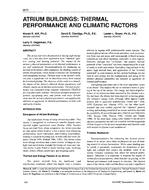
3873 — Atrium Buildings – Thermal Performance and Climatic Factors
The atrium has been documented as having high energy costs, but it has also been reported to have “inherent” passive cooling and heating potential. The impact of the atrium’s physical parameters on its thermal performance is not well understood. Recommendations for enhancing its thermal performance often emphasise the shading control of atrium fenestration, which might counteract the daylighting and sunlighting strategy. Thermal mass in the atrium’s walls can play a significant role in absorbing excess heat caused by oversized glazing. The objective of this study is to identify the impact of the atrium’s physical design parameters and climatic region on its thermal performance. Thermal performance was evaluated using computer simulation (TRYNSYS) for cold and warm climates. Variations included atrium proportion, top-glazing area, and atrium wall mass. Results show that the atrium’s physical parameters can significantly alleviate or aggravate its thermal performance in both cold and warm climates.
KEYWORDS: year 1995, atria, performance, weather, climate, passive, cooling, heating, heat flow, calculating, designing, sizing, glazing, solar radiation, temperature stratification, ventilation, shades, natural lighting, thermal comfort, luminance, measuring
Citation: ASHRAE Trans. 1995, Vol.101, Part 1, Paper number 3873, 454-460, 7 figs., 4 tabs., refs.
Product Details
- Published:
- 1995
- File Size:
- 1 file , 890 KB
- Product Code(s):
- D-16747


